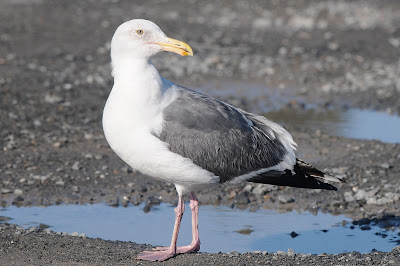We spun over to Bodega Bay in Sonoma County this weekend.
Most of our highlights came from our first stop, the well-known Diekmann's Bay Store. I think the very first bird we saw was the continuing BLACK-HEADED GROSBEAK:
I should add with the above photos that distinguishing pheucticus grosbeaks can be somewhat tricky. With adult male breeding birds not yet in the picture, we're left with 1st-winter birds and nonbreeding adults. Identifying it would be easier if the breast was all orange with no streaks (1st-winter male BHGR) or if there was heavy streaking across the entire breast (adult nonbreeding female RBGR). However, we're stuck in the middle with some orange and streaking. We can focus then on adult nonbreeding female Black-headed and 1st-winter male Rose-breasted. I'm leaning towards this being a nonbreeding female BHGR. I'm wondering if the bicolored bill, best seen in the last picture, might be the best factor pointing towards BHGR? Any thoughts out there from birders used to making that call?
I'll admit, it was enjoyable seeing 5 warbler species in a day in January. Here is a TOWNSEND'S WARBLER:
... a YELLOW WARBLER:
.... an ORANGE-CROWNED WARBLER:
.. and this NASHVILLE WARBLER which has also been somewhat reliable:
A brief walk around "Hole in the Head" yielded 4.3 million YELLOW-RUMPED WARBLERS. Here is one:
This "SOOTY" FOX SPARROW was downright sharp:
We also checked out Porto Bodega where the usual suspects were around. I snapped a few pictures of a couple of different PACIFIC LOONS, noticing especially the differences in the "bumps" on the forehead:
When this predator comes around....
... all the MARBLED GODWITS and WILLETS completely lose their cool. In fact, we saw dozens of godwits actually land on the water and swim around "duck style". They all were able to pop up off the water and take flight once the danger had passed:
Hmm, a gull. Think the mantle is dark enough for a pure Western? Doesn't the yellowish orbital ring and pale eye point towards Western? Based on the dark markings on the bill I'm guessing this is a 3rd cycle going into 4th? I'm not sure if the wing coverts are ratty or just oiled/dirty/wet....


















































